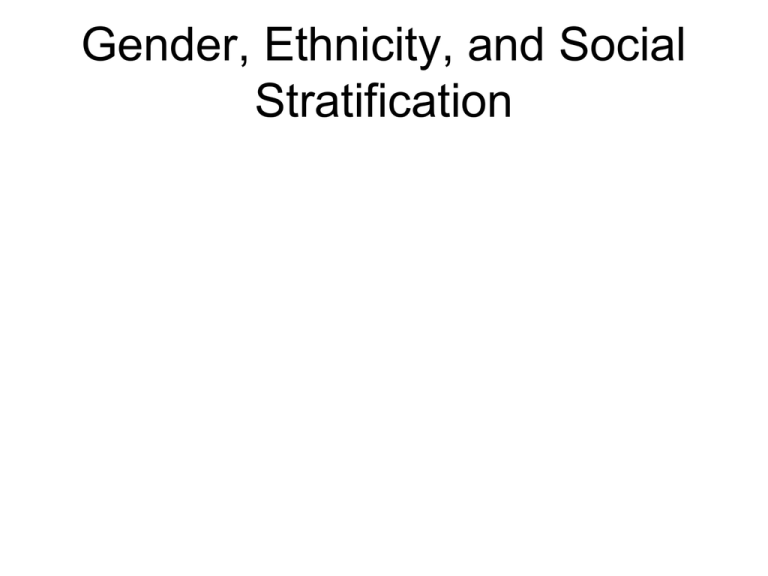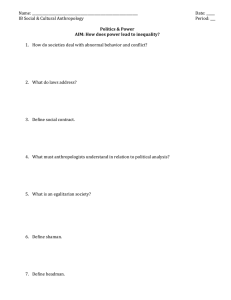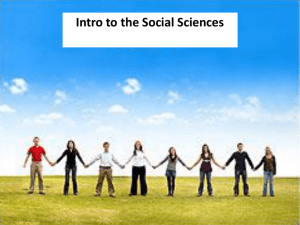
Gender, Ethnicity, and Social
Stratification
Gender and Anthropology
• interest in hierarchical relations between men
and women has been a feature of anthropology
since its earliest days
• anthropology of gender has been key in
establishing that sexual inequality is not a
biological fact but instead and cultural and
historical one
• the body is "simultaneously a physical and
symbolic artifact, both naturally and culturally
produced, anchored in a particular historical
moment" (Scheper-Hughes & Lock)
development of the study of sex,
sexuality and gender in
anthropology
• Anthropology of Women early 1970's attention
to the lack of women in standard ethnographies
• Anthropology of Gender challenged the basis
for understanding social roles of male and
female
• Feminist Anthropology challenged the
biological basis of sex and sexuality
– and the foundations of anthropology as it had been
done
SEX, SEXUALITY, GENDER
• not the same thing
• all societies distinguish between males
and females
• a very few societies recognize a third,
sexually intermediate category
SEX
• differences in biology
• Socially & culturally marked/constructed
SEXUALITY (reproduction)
• all societies regulate sexuality
– lots of variation cross-culturally
• degree of restrictiveness not always
consistent through life span
– adolescence vs. adulthood
• Varieties of “normative” sexual orientation
– Heterosexual, homosexual, transexual
• Sexuality in societies change over time
GENDER
• GENDER - the cultural construction of
male & female characteristics
– vs. the biological nature of men & women
• SEX differences are biological - GENDER
differences are cultural
• behavioral & attitudinal differences from
social & cultural rather than biological
point of view
GENDER ROLES, STEREOTYPES,
STRATIFICATION
• gender roles - tasks & activities that a culture
assigns to sexes
• gender stereotypes - oversimplified strongly
held ideas about the characteristics of men &
women & third sex-third gender
• gender stratification - unequal distribution of
rewards (socially valued resources, power,
prestige, personal freedom) between men &
women reflecting their position in the social
hierarchy
universals versus particulars
• universal subordination of women is often
cited as one of the true cross-cultural
universals, a pan-cultural fact
– Engels called it the “world historical defeat of
women”
• even so the particulars of women’s roles,
statuses, power, and value differ
tremendously by culture
persistence of dualisms in
ideologies of gender
• a particular view of men and women as
opposite kinds of creatures both
biologically and culturally
• nature/culture
• domestic/public
• reproduction/production
Reproduction and Social Roles
• roles - those minimal institutions and
modes of activity that are organized
immediately around one or more mothers
and their children
• women everywhere lactate & give birth to
children
• likely to be associated with child rearing &
responsibilities of the home
a long running controversy in
anthropology
• Sherry Ortner’s famous article “Is
Female to Male as Nature is to Culture”
• argument is that across cultures, women
are more often associated with nature and
the natural and are therefore denigrated
• Ortner - in reality women are no further nor
closer to nature than men - cultural
valuations make women appear closer to
nature than men
The “Third Gender”
• essentialism of western ideas of sexual
dimorphism - dichotomized into natural & then
moral entities of male & female that are given to
all persons, one or the other
• committed western view of sex and gender as
dichotomous, ascribed, unchanging
• other categories - every society including our
own is at some time or other faced with people
who do not fit into its sex & gender categories
The “Third Gender”
• a significant number of people are born
with genitalia that is neither clearly male or
female
– Hermaphrodites
• persons who change their biological sex
• persons who exhibit behavior deemed
appropriate for the opposite sex
• persons who take on other gender roles
other than those indicated by their genitals
Third Gender: Western Bias
• multiple cultural & historical worlds in which people
of divergent gender & sexual desire exist
– margins or borders of society
• may pass as normal to remain hidden in the official
ideology & everyday commerce of social life
• when discovered - iconic matter out of place "monsters of the cultural imagination“
• third gender as sexual deviance a common theme
in US
– evolution & religious doctrine
– heterosexuality the highest form, the most moral way of
life, its natural
Third Gender Cross-Culturally
• provokes us to reexamine our own
assumptions regarding our gender system
• emphasizes gender role alternatives as
adaptations to economic and political
conditions rather than as "deviant" and
idiosyncratic behavior
• rigid dichotomozation of genders is a means
of perpetuating the domination of females by
males and patriarchal institutions.
RETHINKING SUBORDINATION
• Ardener - muted models that underlie male
discourse
• diversity of one life or many lives
• gender roles, stereotypes, stratification
– changes over time
– changes with position in lifecycle
– status of men & women i.e. in male dominant
societies
• decision making roles belong to men but as
women reach menopause; change with marriage
status, virgins, wives, widows (and men)
RETHINKING SUBORDINATION
• women, like men, are social actors who work in
structured ways to achieve desired ends
• formal authority structure of a society may
declare that women are impotent & irrelevant
• but attention to women's strategies & motives,
sorts of choices, relationships established, ends
achieved indicates women have good deal of
power
• strategies appear deviant & disruptive
– actual components of how social life proceeds
Social difference
• Basis for recognition of difference within
and between social groups
• Relationship to political power and
inequality
• Beyond the face to face community
Status & Social Difference
• status - ascribed & achieved
• ascribed status - social positions that people
hold by virtue of birth
– sex, age, family relationships, birth into class or
caste
• achieved status - social positions attained
as a result of individual action
• shift from homogeneous kin based societies
(mechanic) to heterogeneous societies of
associations (organic) involves growth in
importance of achieved
Social Stratification
• inequality in society
• the unequal distribution of goods and services,
rights and obligations, power and prestige
• all attributes of positions in society, not attributes
of individuals
• Stratified society is:
– when a society exhibits stratification it means that there
are significant breaks in the distribution of goods
services, rights obligations power prestige
• as a result of which are formed collectivities or
groups we call strata
race
• There are no biological human races
• up until 14th cent. in Europe cultural & social
evolution based on the idea of progress
from kin-based societies to civil society
through governance & law
• after 16th cent. in Europe ideas of blood
were used to characterize difference
race and social difference
• Race as social grouping based on perceived
physical differences and cloaked in the
language of biology
• social races – groups assumed to have a
biological basis but social constructed
• Racism – systematic social and political bias
based on idea of race
– Operates as a form of class
Social races
• Race exists as a cultural construct
• Racism builds upon idea that personality is linked
with hereditary characteristics which differ
between races
• Race is important for academics studying local
discourses on ethnicity
• Race relations as a special case of ethnicity
• Race as the categorization of people
• Operates as an ASCRIBED status of personhood
American Anthropological Assoc.
statement on race
• “Evidence from the analysis of genetics (e.g.,
DNA) indicates that most physical variation, about
94%, lies within so-called racial groups.
• Conventional geographic ‘racial’ groupings differ
from one another only in about 6% of their
genes….
• ‘Race’ thus evolved as a world view, a body of
prejudgments that distorts our ideas about human
differences and group behavior….
• The ‘racial’ world view was invented to assign
some groups to perpetual low status, while others
were permitted access to privilege, power, and
wealth”
from race to ethnicity
• ethnicity forged in the process of historical
time
• subject to shifts in meaning
– shifts in referents or markers of ethnic identity
• subject to political manipulations
• ethnic identity is not a function of primordial
ties, although it may be described as such
• always the genesis of specific historical
forces that are simultaneously structural &
cultural
building blocks of ethnicity/ethnic
identity
• associated with distinctions between language,
religion, historical experience, geographic
isolation, kinship, notions of race (phenotype)
• may include collective name, belief in common
descent, sense of solidarity, association with a
specific territory, clothing, house types, personal
adornment, food, technology, economic activities,
general lifestyle
cultural markers of difference must
be visible to members and nonmembers
• valued markers of difference by insiders
may become comic or derided by outsiders
• caricature and exaggeration frequently mark
outsider depictions of boundary
mechanisms
– stereotype is one form
ethnicity and boundaries
• where there is a group there is some sort of
boundary
• where there are boundaries there are
mechanisms for maintaining boundaries
– cultural markers of difference that must be
visible to members and non-members
• Code switching
• Marked and unmarked categories
Boundary maintenance
• Social boundaries that may have territorial
counterparts
• The ethnic boundary canalizes social life –
complex organization of behavior and social
relations – playing the same game
• Distinctions between us and them criteria for
judgement of value and performance and
restrictions on interactions
– Allows for the persistence of cultural differences
– Identities are signaled as well as embraced
• All ethnic groups in a poly-ethnic society act to
maintain dichotomies and differences
ethnogenesis
• fluidity of ethnic identity
• ethnic groups vanish, people move between
ethnic groups, new ethnic groups come into
existence
• ethnogenesis
– emergence of new ethnic group, part of existing
group splits & forms new ethnic group,
members of two or more groups fuse
political organization and ethnicity
• ethnicity is founded upon structural
inequities among dissimilar groups into a
single political entity
• based on cultural differences & similarities
perceived as shared
Ethnicity as identity formation and
political organization
• Ethnic groups – those human groups that entertain
a SUBJECTIVE belief in their common descent
because of similarities of physical type or of
customs or of both, or because of memories of
colonization and migration
• Belief in group affinity can have important
consequences for the formation of a political
community
• feelings of ethnicity & associated behavior vary in
intensity within groups (& persons) over time &
space






